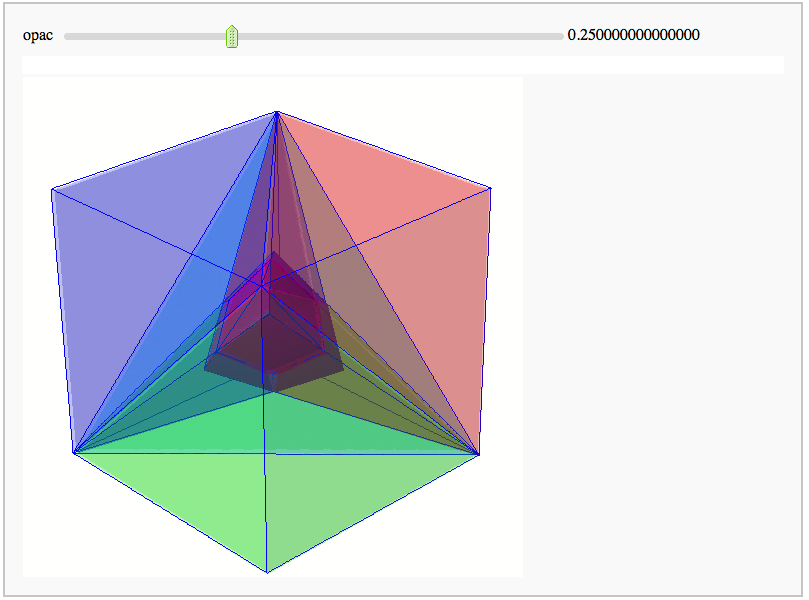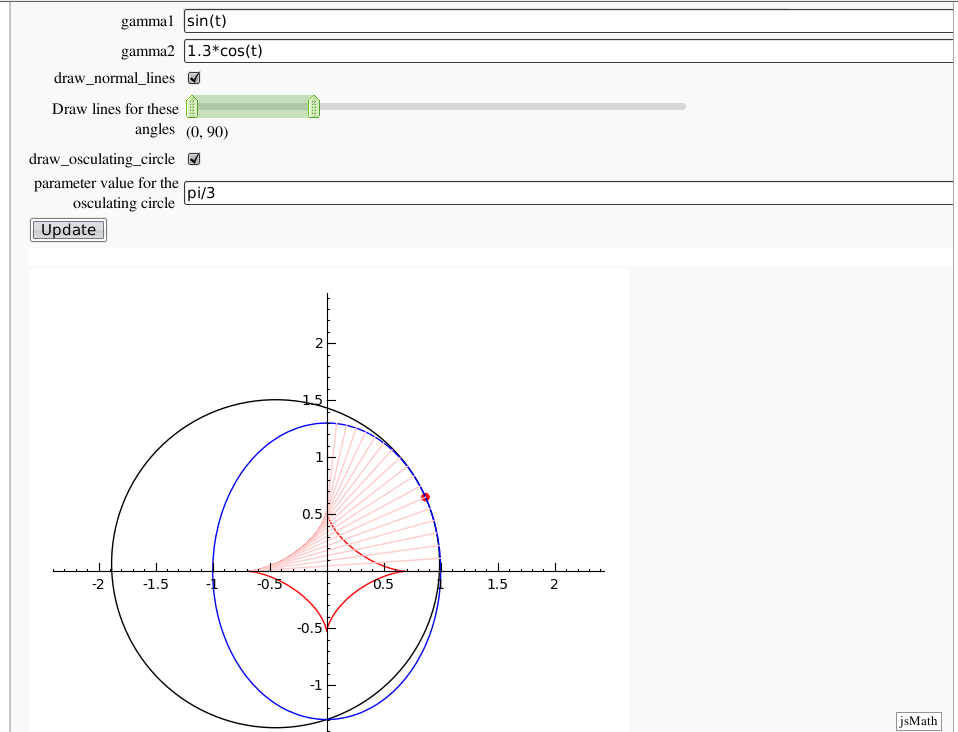|
Size: 3053
Comment:
|
Size: 3572
Comment: slight improvements over previous version of Evolutes
|
| Deletions are marked like this. | Additions are marked like this. |
| Line 35: | Line 35: |
| by Pablo Angulo. Computes the evolute of a plane curve given in parametric coordinates. The curve must be parametrized from the interval [0,2pi]. The following animation was done with similar code: http://www.uam.es/personal_pdi/ciencias/pangulo/adjuntos/evoluta.gif |
by Pablo Angulo. Computes the evolute of a plane curve given in parametric coordinates. The curve must be parametrized from the interval [0,2pi]. |
| Line 44: | Line 43: |
| def _( gamma1=input_box(default=sin(t)), gamma2=input_box(default=1.3*cos(t)), rango_angulos=range_slider(0,360,paso_angulo,(0,45),label='Draw lines for these angles') ): print rango_angulos |
def _( gamma1=input_box(default=sin(t)), gamma2=input_box(default=1.3*cos(t)), draw_normal_lines=True, rango_angulos=range_slider(0,360,paso_angulo,(0,90),label='Draw lines for these angles'), draw_osculating_circle=True, t0=input_box(default=pi/3,label='parameter value for the osculating circle'), auto_update=False ): |
| Line 55: | Line 58: |
| radio=np^3/sqrt(np^2*npp^2-pe^2) | curvatura=(gammap[1]*gammapp[0]-gammap[0]*gammapp[1])/norma(gammap)^3 radio=1/curvatura |
| Line 57: | Line 62: |
| Line 60: | Line 65: |
| grafica=curva+evoluta | |
| Line 61: | Line 67: |
| f=2*pi/360 lineas=sum(line2d([(gamma[0](t=i*f), gamma[1](t=i*f)), (centros[0](t=i*f), centros[1](t=i*f)) ], thickness=1,rgbcolor=(1,0.8,0.8)) for i in range(rango_angulos[0],rango_angulos[1]+paso_angulo,paso_angulo)) |
if draw_normal_lines: f=2*pi/360 lineas=sum(line2d( [ (gamma[0](t=i*f), gamma[1](t=i*f)), (centros[0](t=i*f), centros[1](t=i*f)) ], thickness=1,rgbcolor=(1,0.8,0.8)) for i in range(rango_angulos[0], rango_angulos[1]+paso_angulo, paso_angulo)) grafica+=lineas if draw_osculating_circle and 0<t0<2*pi: punto=point((gamma[0](t=t0), gamma[1](t=t0)), rgbcolor=hue(0),pointsize=30) circulo=circle( (centros[0](t=t0), centros[1](t=t0)), radio(t=t0) ) grafica+=punto+circulo |
| Line 64: | Line 80: |
| show(curva+evoluta+lineas,aspect_ratio=1,xmin=-2,xmax=2,ymin=-2,ymax=2) }}} |
show(grafica,aspect_ratio=1,xmin=-2,xmax=2,ymin=-2,ymax=2)}}} |
Sage Interactions - Geometry
goto interact main page
Intersecting tetrahedral reflections
by Marshall Hampton. Inspired by a question from Hans Schepker of Glass Geometry.
#Pairs of tetrahedra, one the reflection of the other in the internal face, are joined by union operations:
p1 = Polyhedron(vertices = [[1,1,1],[1,1,0],[0,1,1],[1,0,1]])
p2 = Polyhedron(vertices = [[1/3,1/3,1/3],[1,1,0],[0,1,1],[1,0,1]])
p12 = p1.union(p2)
p3 = Polyhedron(vertices = [[0,0,1],[0,0,0],[0,1,1],[1,0,1]])
p4 = Polyhedron(vertices = [[2/3,2/3,1/3],[0,0,0],[0,1,1],[1,0,1]])
p34 = p3.union(p4)
p5 = Polyhedron(vertices = [[1,0,0],[1,0,1],[0,0,0],[1,1,0]])
p6 = Polyhedron(vertices = [[1/3,2/3,2/3],[1,0,1],[0,0,0],[1,1,0]])
p56 = p5.union(p6)
p7 = Polyhedron(vertices = [[0,1,0],[0,0,0],[1,1,0],[0,1,1]])
p8 = Polyhedron(vertices = [[2/3,1/3,2/3],[0,0,0],[1,1,0],[0,1,1]])
p78 = p7.union(p8)
pti = p12.intersection(p34).intersection(p56).intersection(p78)
@interact
def tetra_plot(opac = slider(srange(0,1.0,.25), default = .25)):
p12r = p12.render_wireframe()+p12.render_solid(opacity = opac)
p34r = p34.render_wireframe()+p34.render_solid(rgbcolor = (0,0,1),opacity = opac)
p56r = p56.render_wireframe()+p56.render_solid(rgbcolor = (0,1,0),opacity = opac)
p78r = p78.render_wireframe()+p78.render_solid(rgbcolor = (0,1,1),opacity = opac)
ptir = pti.render_wireframe()+pti.render_solid(rgbcolor = (1,0,1),opacity = .9)
show(p12r+p34r+p56r+p78r+ptir, frame = False)
Evolutes
by Pablo Angulo. Computes the evolute of a plane curve given in parametric coordinates. The curve must be parametrized from the interval [0,2pi].
var('t');
def norma(v):
return sqrt(sum(x^2 for x in v))
paso_angulo=5
@interact
def _( gamma1=input_box(default=sin(t)), gamma2=input_box(default=1.3*cos(t)),
draw_normal_lines=True,
rango_angulos=range_slider(0,360,paso_angulo,(0,90),label='Draw lines for these angles'),
draw_osculating_circle=True,
t0=input_box(default=pi/3,label='parameter value for the osculating circle'),
auto_update=False ):
gamma=(gamma1,gamma2)
gammap=(gamma[0].derivative(),gamma[1].derivative())
normal=(gammap[1]/norma(gammap), -gammap[0]/norma(gammap))
gammapp=(gammap[0].derivative(),gammap[1].derivative())
np=norma(gammap)
npp=norma(gammapp)
pe=gammap[0]*gammapp[0]+gammap[1]*gammapp[1]
curvatura=(gammap[1]*gammapp[0]-gammap[0]*gammapp[1])/norma(gammap)^3
radio=1/curvatura
centros=(gamma[0]+radio*normal[0],gamma[1]+radio*normal[1])
curva=parametric_plot(gamma,(t,0,2*pi))
evoluta=parametric_plot(centros,(t,0,2*pi), color='red')
grafica=curva+evoluta
if draw_normal_lines:
f=2*pi/360
lineas=sum(line2d( [ (gamma[0](t=i*f), gamma[1](t=i*f)),
(centros[0](t=i*f), centros[1](t=i*f)) ],
thickness=1,rgbcolor=(1,0.8,0.8))
for i in range(rango_angulos[0], rango_angulos[1]+paso_angulo, paso_angulo))
grafica+=lineas
if draw_osculating_circle and 0<t0<2*pi:
punto=point((gamma[0](t=t0), gamma[1](t=t0)), rgbcolor=hue(0),pointsize=30)
circulo=circle( (centros[0](t=t0), centros[1](t=t0)), radio(t=t0) )
grafica+=punto+circulo
show(grafica,aspect_ratio=1,xmin=-2,xmax=2,ymin=-2,ymax=2)
